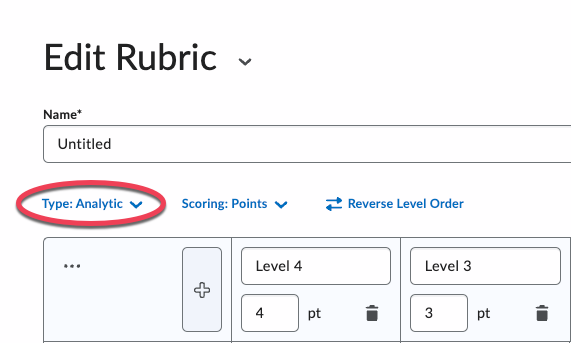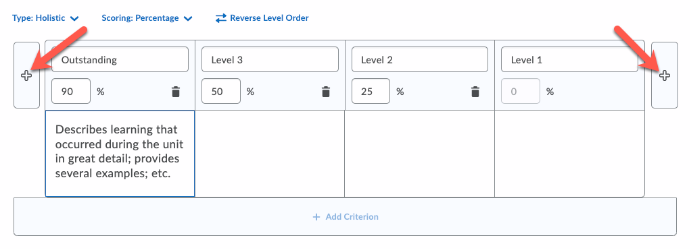Rubrics
On This Page
Manage Rubric and Score Visibility
Connect Rubrics to Assignments
What is Rubrics?
Rubrics is an assessment tool used to evaluate activities based on a predefined set of criteria.
To access the Rubrics tool, select the Course Admin link on the Navbar. Select Rubrics under the Assessment header.
Create an Analytic Rubric
An analytic rubric describes levels of performance by defining criteria. The performance levels in an analytic rubric can communicate expectations and detailed feedback to participants. The levels allow for consistent and objective assessment.
Step 1
In the Rubrics tool, select New Rubric.
Step 2
Enter a Name for the rubric.
Step 3
Analytic is the default type. Once you save your rubric, you will not be able to change the rubric type.

Step 4
Select Scoring: (Points is the default): to select how you want to assess the rubric.
- Points: Levels use text and point values such as "Excellent (100 points)" "Fair (75 points)." Point values are the same across criteria.
- Custom Points: Points given for each criterion can be customized. For example, the "Content" of the assignment might be worth 10 of the available points, while "Spelling and Grammar" might only be worth 5.
- No Score: Levels are indicated by text only, such as "Excellent," "Fair," and "Poor.”
Step 5
The rubric contains four Levels by default. Change the names and point values of the Levels by selecting the text boxes. To add new Levels, select the Add new level button (plus sign) to the left (before the current columns) or the right (after the current columns) of the existing Levels.

Step 6
Select inside each text box under each Level to provide a detailed description of that level of achievement. Leave default feedback for each Level of a Criterion in the Initial Feedback text box.

Step 7
To remove Levels, select the trash-can icon at the top of the Level column you want to delete.
Step 8
The rubric contains three Criteria by default. You can change the names of each criterion by selecting on the text boxes. To add new Criteria, select the + Add Criterion link at the bottom. To copy an existing Criterion, select the three dots next to its name and select Copy Row.
Step 9
To remove Criteria, select the Actions for Criterion (3 dots next to the Criterion) and select Delete Row.

Step 10
If you need to assess various aspects of an assignment separately with a different set of criteria, such as grammar usage or writing style, you can add another Criteria Group. Each Criteria Group can include different descriptions and point values. To add the new group, select the Add Criteria Group button.

Step 11
The Overall Score section totals the scores earned on each Level for each Criterion. You do not need to change anything about the Overall Score section, but if you'd like, you can customize the names and point ranges of these levels by selecting the text boxes
Important:
Do not delete the levels in Overall Score as the rubric will not function properly without them.
Step 12
Select the Options menu to customize the visibility and other details of this rubric.
- Rubric Visibility: Choose whether students can view the rubric before they complete or submit the activity.
- Learning Outcomes: Choose to automatically or manually map achievement to the levels in your rubric.
- Score Visibility: Choose whether students can see their scores in the rubric
Step 13
Select Close when you are finished working on the rubric.
Create a Holistic Rubric
Holistic rubrics use one overall score to assess an assignment as a whole.
Note
The Add Criterion button is unavailable while creating a Holistic rubric, as this rubric is not criteria-based. If you intend to use a set of criteria, see the instructions in Creating an Analytical rubric.
Step 1
Select New Rubric.
Step 2
Enter a Name for your rubric.
Step 3
Select Type and select Holistic. Once you save your rubric, you will not be able to change the rubric type.
Step 4
Select Scoring to select how you'd like to assess the rubric.
- Percentage: Assign a percentage to the Level that students achieve in the rubric
- No Score: Performance levels are indicated by text only, such as “Excellent” and “Fair.” Participants see no numerical value associated with performance levels.

Step 5
To add new Levels, select the Add new level button (plus sign) to the left (before the current columns) or the right (after the current columns) of the existing Levels.

Step 6
To change the name and percentage values (if using a percentage Scoring system), select inside the text boxes. Add a description of the level of achievement by selecting the text box under each Level.
Step 7
To remove Levels, select the Remove Level icon (trashcan icon) on the Level you want to delete.
Step 8
Select the Options menu to customize the visibility and other details of this rubric.
- Rubric Visibility: Choose whether students can view the rubric before they complete or submit the activity.
- Learning Outcomes: Choose to automatically or manually map achievement to the levels in your rubric.
- Score Visibility: Choose whether students can see their scores in the rubric
Step 9
Select Close when you are finished with the rubric.
Manage Rubric and Score Visibility
Choose if the rubric will be visible to students and when.
D2L has three options for rubric visibility and hiding scores, both listed under Options.
Option 1
Rubric is visible to students: Students can see the empty Rubric before submitting their work and see a link to their graded Rubric once assessments are published.
Option 2
Rubric is hidden from students: Only instructors, TAs, and Graders will see the rubric attached to a tool.
Note
If the Include rubric feedback in overall feedback option is selected, students will see any feedback left on the rubric when they view their score in Grades / the tool where the rubric is attached.
Option 3
Rubric is hidden until feedback is published: Students will see a link to their graded Rubric once assessments are published.
Option 4
Hide scores from students: If this box is checked, students will still see check marks without a numerical score in each Level and the Overall Score Level in the rubric. The published score for the entire assignment will appear in the Score field.
Publish a Completed Rubric
You must publish your rubric before you can associate it with course activities.
Important
Once a rubric has been associated with an activity in your D2L course site and assessments have been made using that rubric, you can no longer change it. Before publishing your rubric for use, check everything to ensure it is how you want it.
Step 1
Select the Actions Menu icon next to the rubric you want to change the status for.
Step 2
Select Set Status.
Step 3
Select Published.
Edit a Rubric
Edit text within a rubric, make a copy of or delete rubrics you no longer need.
There are limited changes that can be made to a rubric once it has been published and used to assess student work on an activity (e.g. Assignments, Discussions).
Note
Structural changes (e.g., adding criteria, changing values, etc.) cannot be made with the Edit Text option. For these changes, you will need to make a copy of the rubric that can then be fully edited and attach the copy to the intended activity.]
To edit text within a rubric (e.g., Level names, Criteria names, Criteria descriptions, Initial Feedback fields):
Step 1
Select the Actions Menu icon next to the appropriate rubric and choose Edit Options.
Step 2
An alert will appear at the top of the screen that reads, "The rubric is locked to structural changes because it has already been used to assess learner work." Choose the Edit Text button on the right side of this alert.
Step 3
A pop-up window will appear, asking you to confirm that you want to edit this assessed rubric. Be sure to read this note carefully to learn about how changes will be implemented. Select Edit Text to move forward.
Step 4
Select any text fields and make the necessary changes. Changes are saved automatically. When you are finished, select Close.
Copy a Rubric
Select the Actions Menu icon next to the rubric you'd like to copy and select Copy. You can then make any desired changes to the copy that is created.
Delete a Rubric
Step 1
Select the Actions Menu icon to the right of the rubric you'd like to delete and select Delete.
Step 2
Select Delete on the confirmation window that opens.
Step 3
If you can't delete a rubric, go to the associated activity (Assignment, Discussion, etc.), select Edit for the activity, and select the X next to the rubric name to remove it. Then, follow the steps above to delete it permanently from the course.
Connect Rubrics to Assignments
Step 1
Select Assignments in the Navbar.
Step 2
Select the Actions Menu icon next to the Assignment name, and select Edit Assignment.
Step 3
Select to expand the Evaluation & Feedback panel. Select Add Rubric.
Step 4
Choose Add Existing.
Note
Alternatively, you can choose Create New to build a new rubric and attach it to the quiz question.
Step 5
Select the checkbox next to the rubric you want to attach, then select Add Selected.
Step 6
Select Save and Close.
Connect Rubrics to Discussions
Step 1
Select Discussions in the navbar.
Step 2
Select the Actions Menu icon next to the Topic name, and select Edit Topic.
Step 3
Select the Assessment tab.
Step 4
Choose Add Rubric.
Step 5
Choose Add Existing.
Note
Alternatively, you can choose Create New to build a new rubric and attach it to the quiz question.
Step 6
Select the checkbox next to the rubric you want to attach, then choose Add Selected.
Step 7
Select Save and Close.
Connect Rubrics to Written Response Quiz Questions
Step 1
Select Quizzes in the navbar.
Step 2
Select the Actions Menu icon next to the name of the quiz and select Edit.
Step 3
To add a rubric, first select the question you intend to modify. Then choose Add Rubric.
Step 4
To attach a rubric, select Add Existing to use one that has already been created.
Note
Alternatively, you can choose Create New to build a new rubric and attach it to the quiz question.
Step 5
Select the checkbox next to the rubric you want to attach, then choose Add Selected.
Step 6
Select Save to save your edits to the quiz question, then Save and Close to save the quiz.
